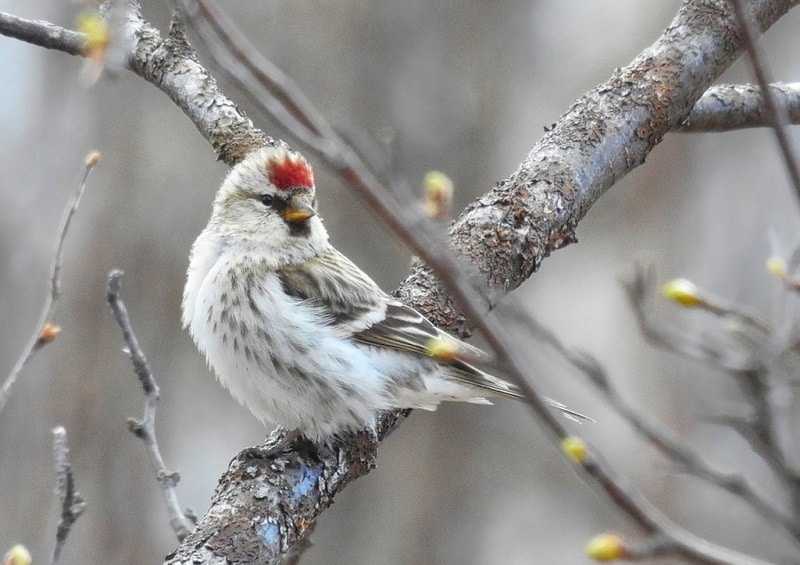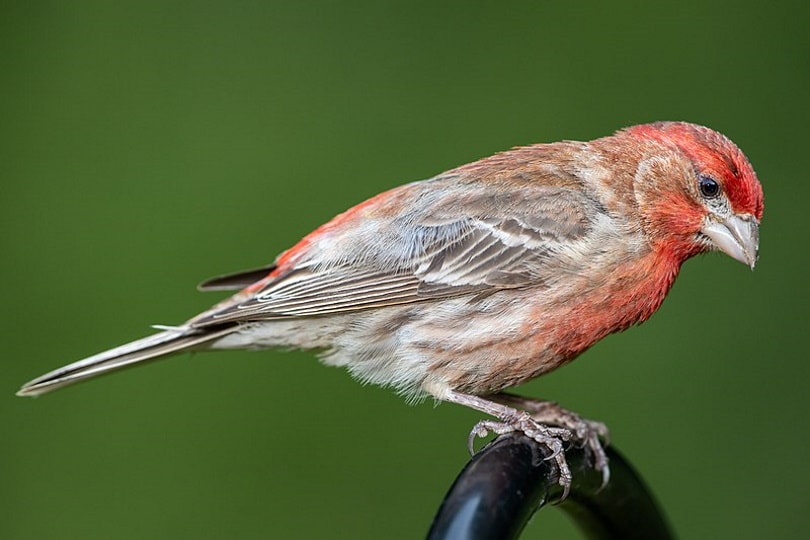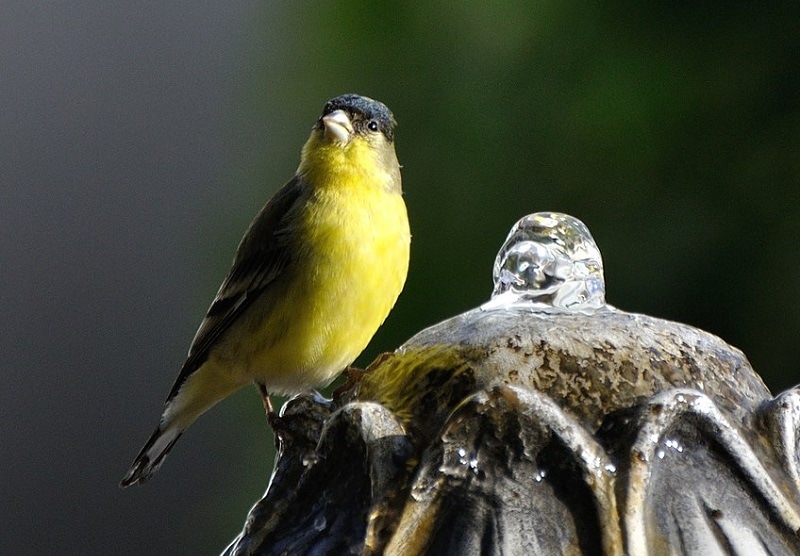17 Finch Species Found in the United States
Last Updated on

Finches are a member of the Fringillidae family of the Passeriformes order. Collectively, the group is often called the New World seedeaters, and it also includes longspurs, chaffinches, and more. This is a family of songbirds, and its members exhibit bright colors and beautiful songs.
Across the world, there are over 229 species in the Fringillidae family. But in the United States, there are just 17. Unfortunately, more than half of the finch species that live in North America are declining in number. Even the Purple Finch, New Hampshire’s state bird, is expected to lose a large majority of its summer range. Other species are faring even worse, such as the cassia Crossbill, of which only an estimated 6,000 specimens remain.
The following 17 finch species can all be found in the United States. While not all of them are endangered, many are on conservation watch lists because of their declining numbers. Let’s take a closer look at these beautiful birds and see what we’d all be missing if any of these species were to go extinct.

The 17 Finch Species Found in the United States
1. American Goldfinch

- Population in North America: 43 million
- Population Trend: Growing
- Conservation Status: Least concern
- Size: 4.3–5.1 inches
- Weight: 0.4–0.7 ounces
- Wingspan: 7.5–8.7 inches
The American Goldfinch is a common sight across America. You’ll often see them at feeders year-round, though they’re most commonly found there in winter. These are small finches with short, notched tails and conical bills that are also short. In spring and early summer, males are bright yellow with black foreheads and wings. Females are duller yellow on the underside and olive-colored on the top. In the winter, the birds are plain, displaying a brown color with black wings that show two pale wing bars.
2. Black Rosy–Finch

- Population in North America: 20,000
- Population Trend: Shrinking
- Conservation Status: Endangered
- Size: 5.5–6.3 inches
- Weight: 0.8–1.1 ounces
- Wingspan: 13 inches
Breeding adult Black Rosy–Finches display deep black coloration with pink highlights on the wings and lower belly. In winter, they form large flocks and forage for seeds and insects at the melting edges of snowbanks. When they’re not breeding, these birds will be brown rather than black, though they still display the same pink highlights. Nonbreeders have yellow bills but breeder’s bills are black.
3. Brown–capped Rosy–Finch

- Population in North America: 45,000
- Population Trend: Shrinking
- Conservation Status: Endangered
- Size: 5.5–6.3 inches
- Weight: 0.8–1.2 ounces
- Wingspan: 13 inches
These are medium-sized finches that are mainly cinnamon-brown in color, except for red or pink on their wings, rump, and bellies. Their bills are black during the breeding season but yellow when not breeding.
4. Cassia Crossbill
https://www.instagram.com/p/CM0qbCYAzn2/
- Population in North America: 6,000
- Population Trend: Shrinking
- Conservation Status: Critically endangered
- Size: Unknown
- Weight: 1–2 ounces
- Wingspan: 7–9 inches
The Cassia Crossbill is so named for its crisscrossed bill. They’re closely related to the far more common Red Crossbill and only recently became classified as a separate species in 2017. These birds don’t migrate. Instead, they stay in the same place year-round, which is a single county in the state of Idaho.
5. Cassin’s Finch

- Population in North America: 3 million
- Population Trend: Shrinking
- Conservation Status: Least concern
- Size: 6–7 inches
- Weight: 0.8–1.2 ounces
- Wingspan: 9.8–10.6 inches
Cassin’s Finches have long, straight bills for their size with notched tails. They have short wings that project farther down the tail when perched than you’ll see in other finch species. Adult males will display a pink color on most of their bodies with a bright red crown. Immature males and all females are far less colorful, boasting brown and white coloration all over.
6. Common Redpoll

- Population in North America: 38 million
- Population Trend: Unknown
- Conservation Status: Least concern
- Size: 4.7–5.5 inches
- Weight: 0.4–0.7 ounces
- Wingspan: 7.5–8.7 inches
You can identify a Common Redpoll by the small red patch on their foreheads. You’ll also notice the yellow bill surrounded by black feathering. Males will display pale red on their chests and upper flanks. Common Redpolls travel in large flocks that can contain several hundred birds.
7. Evening Grosbeak

- Population in North America: 3.4 million
- Population Trend: Shrinking
- Conservation Status: Vulnerable
- Size: 6.3–7.1 inches
- Weight: 1.9–2.6 ounces
- Wingspan: 11.8–14.2 inches
Evening Grosbeaks are rather large for finches, with thick and powerful bills attached to heavyset bodies. Males are yellow and black with a large white patch on each wing. Their heads are dark except for a bright-yellow strip across the eyes. Females and males that aren’t yet mature will be gray with white and black wings, though you’ll see a slight yellow-green tint on the flanks and neck.
8. Gray–crowned Rosy–Finch

- Population in North America: 200,000
- Population Trend: Unknown
- Conservation Status: Least concern
- Size: 5.5–8.3 inches
- Weight: 0.8–2.1 ounces
- Wingspan: 13 inches
You’ll often find Gray-crowned Rosy-Finches in large flocks with several other species of rosy-finch in the winter, generally hopping around on the ground near snowmelt in search of seeds and insects. Mature males are brown with pink dispersed across the body. Their heads are gray on the sides with black on the throat and forecrown. Females look similar, though they show less pink. Juveniles lack the pink and are brown with gray wings.
9. Hoary Redpoll

- Population in North America: 10 million
- Population Trend: Unknown
- Conservation Status: Least concern
- Size: 4.7–5.5 inches
- Weight: 0.4–0.7 ounces
- Wingspan: 7.5–8.7 inches
Weighing less than an ounce, Hoary Redpolls are tiny finches with even smaller bills that appear to be pushed into their face when compared to a Common Redpoll. Their feathers are fluffed up, which makes them appear larger than they really are. Adults are mostly white with a small red patch on the forecrown. Their wings and tail are a darker gray and feature bright white wing bars. Some Hoary Redpolls might display a reddish tint on their underside.
10. House Finch

- Population in North America: 31 million
- Population Trend: Growing
- Conservation Status: Least concern
- Size: 5.1–5.5 inches
- Weight: 0.6–0.9 ounces
- Wingspan: 7.9–9.8 inches
House Finches have flat, long heads with large beaks for their size. Their wings are quite short though, which makes their tails appear long. Mature males are a deep red around the face and on the upper chest. Their backs are streaked brown and black. Females are much less vibrant, showing only a gray-brown color.
11. Lawrence’s Goldfinch

- Population in North America: 240,000
- Population Trend: Shrinking
- Conservation Status: Least concern
- Size: 3.9–4.7 inches
- Weight: 0.3–0.5 ounces
- Wingspan: 8.1–8.7 inches
These are some of the most striking of all North American finches. Their bodies are mostly a soft gray color, though their faces are black. Bright yellow is strewn throughout the wings and body. Despite their beautiful appearance, many birders are unaware of Lawrence’s Goldfinch because they prefer to remain in the most remote and arid deserts of the southwestern US.
12. Lesser Goldfinch

- Population in North America: 4.7 million
- Population Trend: Growing
- Conservation Status: Least concern
- Size: 3.5–4.3 inches
- Weight: 0.3–0.4 ounces
- Wingspan: 5.9–7.9 inches
Lesser Goldfinches are slender birds with small bills, pointed wings, and notched tails that are quite short. Males are stunning, displaying bright yellow on their entire underside. On the top, they’re a glossy black or even a dull green with small patches of white in the wings. Immature males and all females show dull yellow coloration on the underside with black wings and olive-colored backs.
13. Pine Grosbeak

- Population in North America: 4.4 million
- Population Trend: Shrinking
- Conservation Status: Least Concern
- Size: 7.9–10 inches
- Weight: 1.8–2.8 ounces
- Wingspan: 13 inches
Large finches with plump bodies, the Pine Grosbeak features a thick, yet very short and stubby bill set into a round head. When mature, they display vibrant colors. Males will be red and gray. Females are mostly gray with orange, yellow, or red tinting. All Pine Grosbeaks have gray wings with two white wing bars.
14. Pine Siskin

- Population in North America: 35 million
- Population Trend: Shrinking
- Conservation Status: Least concern
- Size: 4.3–5.5 inches
- Weight: 0.4–0.6 ounces
- Wingspan: 7.1–8.7 inches
Pine Siskins are tiny little songbirds, generally weighing about half an ounce or less. They have a streaked appearance that’s mostly brown and white with flashes of yellow throughout. Though their population appears to be shrinking, with 35 million in North America alone, their conservation status is rated as least concern.
15. Purple Finch

- Population in North America: 5.9 million
- Population Trend: Shrinking
- Conservation Status: Least concern
- Size: 4.7–6.3 inches
- Weight: 0.6–1.1 ounces
- Wingspan: 8.7–10.2 inches
The most standout feature of a Purple Finch is its deep purple coloration. These birds are beautiful, with a lighter pinkish color on the head and chest. Females won’t show any red, though all Purple Finches will exhibit the deep purple coloration that earns them their namesake.
16. Red Crossbill

- Population in North America: 7.8 million
- Population Trend: Shrinking
- Conservation Status: Least concern
- Size: 7.5–8 inches
- Weight: 1.5–2 ounces
- Wingspan: 10.6–11.4 inches
Mature male Red Crossbills are red all over, with wings and tails of a darker shade of red. In contrast, females are yellow and brown; similar in color to immature males. They prefer to live in mature forests, though during irruptions, individuals and large flocks can appear far south or east of their standard range, even showing up in towns, cities, and backyards.
17. White–winged Crossbill

- Population in North America: 35 million
- Population Trend: Growing
- Conservation Status: Least concern
- Size: 5.9–6.7 inches
- Weight: 0.8–0.9 ounces
- Wingspan: 10.2–11 inches
When mature, males have black wings but are rose-pink on most of the rest of their bodies. Younger males and females will be yellow instead. All adults will show black wings and tails with two white wing bars. These birds stay in large flocks all year. They prefer boreal forests of spruce and tamarack, though you’ll find them in hemlock forests and weedy fields during irruptions.
•11 Species of Woodpeckers in Oklahoma (with Pictures)

Conclusion
As you can see, finches represent an incredibly diverse mix of birds that come in practically every color of the rainbow. These songbirds can deliver enchanting serenades with their calls, and are living art when they fly with all of the colors they present. We should all feel lucky that we get to enjoy these wonderful creatures while they’re still here. If things continue down the path they’re currently on, several of these species could be extinct within just a few generations.
Check out some of our top-ranking posts:
- 9 Species of Hawks in Ohio (with Pictures)
- 2 Species of Eagles in California
- 17 Finch Species Found in the United States
Featured Image Credit: Åsa Berndtsson, Wikimedia Commons
Table of Contents
- The 17 Finch Species Found in the United States
- 1. American Goldfinch
- 2. Black Rosy–Finch
- 3. Brown–capped Rosy–Finch
- 4. Cassia Crossbill
- 5. Cassin’s Finch
- 6. Common Redpoll
- 7. Evening Grosbeak
- 8. Gray–crowned Rosy–Finch
- 9. Hoary Redpoll
- 10. House Finch
- 11. Lawrence’s Goldfinch
- 12. Lesser Goldfinch
- 13. Pine Grosbeak
- 14. Pine Siskin
- 15. Purple Finch
- 16. Red Crossbill
- 17. White–winged Crossbill
- Conclusion
About the Author Dean Eby
An avid outdoorsman, Dean spends much of his time adventuring through the diverse terrain of the southwest United States with his closest companion, his dog, Gohan. He gains experience on a full-time journey of exploration. For Dean, few passions lie closer to his heart than learning. An apt researcher and reader, he loves to investigate interesting topics such as history, economics, relationships, pets, politics, and more.
Related Articles:
How to Clean a Refractor Telescope: Step-by-Step Guide
How to Clean a Telescope Eyepiece: Step-by-Step Guide
How to Clean a Rifle Scope: 8 Expert Tips
Monocular vs Telescope: Differences Explained (With Pictures)
What Is a Monocular Used For? 8 Common Functions
How to Clean a Telescope Mirror: 8 Expert Tips
Brightfield vs Phase Contrast Microscopy: The Differences Explained
SkyCamHD Drone Review: Pros, Cons, FAQ, & Verdict
